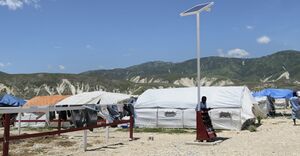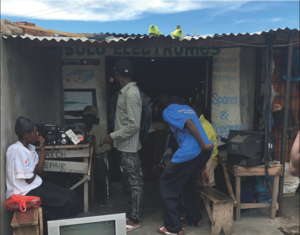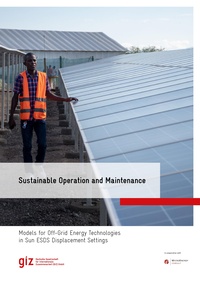Knowledge fuels change - Support energypedia!
For over 10 years, energypedia has been connecting energy experts around the world — helping them share knowledge, learn from each other, and accelerate the global energy transition.
Today, we ask for your support to keep this platform free and accessible to all.
Even a small contribution makes a big difference! If just 10–20% of our 60,000+ monthly visitors donated the equivalent of a cup of coffee — €5 — Energypedia would be fully funded for a whole year.
Is the knowledge you’ve gained through Energypedia this year worth €5 or more?
Your donation keeps the platform running, helps us create new knowledge products, and contributes directly to achieving SDG 7.
Thank you for your support, your donation, big or small, truly matters!
Operation and Maintenance Plan and Glossary for PV Systems
Overview
One important component for establishing sustainable models for the usage of photovoltaic systems and solar energy installations exists in Operation and Maintenance (O&M). Continuous functioning, lowering of levelized cost of electricity (LCOE) and reduction of electronic waste are ensured by frequent O&M of all energy producing installations. Several challenges exist that render the O&M for energy access technologies complex in displacement settings, from the existence of language barriers among refugees, weak presence of solar companies, to the low profitability of operations in camps and settlements.
Background: Energy Access in ESDS Areas
Nguenyyiel Refugee Camp in Ethiopia’s Gambella region, Kalobeyei Settlement in Kenya, Imvepi and Rhino Settlements in Uganda are four of the displacement settings in which GIZ’s Energy Solutions for Displacement Settings (ESDS) supports UNHCR. Improving the energy access for refugees, host community, and social institutions as well as rendering existing energy access solutions in an environmentally and economically sustainable manner are the main measures of this programme. The ESDS Project areas have no access to grid electricity. As a consequence, the population’s main energy sources are:
- fossil fuel based (tadoobas [a tin kerosene lamp], diesel generators, car batteries, torches, dry cells)
- renewable (individual use: solar lanterns – received mostly through donations, solar home systems; community use: institutional solar, solar street lights)
Due to the geographical remoteness of the displacement settings and the low-income of the host communities and the refugees, most of the renewable energy access has been achieved solely with a focus on products, based on humanitarian sector support, partnerships with private sector for piloting different approaches, or through the consumer’s own acquisition.
Improvements by O&M
Little emphasis has been given to servicing the solar energy technologies, particularly through operation and maintenance (O&M) activities. However, this process should by no means be neglected, as O&M of renewable energy technologies, whether for individual or community use, can:
- Maintain the performance of the system, thus reduce its payback period
- Increase the usability of the system, thus increase appliance diversification and income generation opportunities
- Increase the end-user’s ownership on the asset, thus increase energy access through renewable energy
- Reduce probability of abandonment through intensified use, thus reduce sources for e-waste
- Generate business opportunities. For example, the research showed that third-party repair services for pico-solar devices were thriving, creating informal livelihood opportunities for refugees and host communities.
Challenges of Implementing O&M
The main challenges encountered by the consumer of energy (the private sector, the informal sector and the humanitarian and development actors) with the sustainable introduction and scale-up of O&M are:
- Incentives: the lack of incentives for consumers to operate and maintain their systems, for the private sector to offer after-sales services, and for the humanitarian and development sector to implement an energy service procurement approach,
- Standardization: O&M practices vary across technologies, camps and settlements
- Awareness: The private-sector needs to provide consumers with capacity building, while the humanitarian and development sector needs to raise awareness on the importance of O&M for the sustainable implementation of energy access programs.
Improving O&M in the Humanitarian Sector
To improve the O&M of renewable energy technologies in the humanitarian and development sector (not only as consumers of energy, but also as key actors for enabling a sustainable energy access in displacement setting), immediate and medium-term actions can be identified:
IMMEDIATE – Low Threshold, Rapidly Implementable with Low Effort
- Technical solutions for:
- Solar streetlights: installation of specialized hardware (GPS, alarms)
- Solar PV for public facilities: utilization of excess electricity as a charging business to cover O&M expenses
- Energy as a Service:
- Solar lanterns and solar home systems: by incorporating specific training, after-sales services and recollection clauses in procurement contracts
- Awareness and training: of consumers through visual materials displayed in public and crowded sites, and demonstration campaigns
- Inter/intra-institutional working groups: setup in the humanitarian and development sector, to share knowledge, lessons learned and standardize approaches.
MEDIUM-TERM – Require Preparation of Action and Planning
- Technical solutions for:
- Solar streetlights: incentivize owners of SHS (both households and businesses) to acquire and install an exterior light to act as a safety light
- Energy as a Service:
- Solar lanterns: incorporating the informal economy in the servicing approach by training the informal sector on standardized O&M practices
- Solar PV for public facilities: shifting from asset-based procurement to service-based procurement
- Feasibility measurements: on the socioeconomic characteristics of the displacement setting’s end-user
- Inter/intra-institutional working groups: a centralized repository of knowledge, populated with relevant information.
Glossary of O&M and the Maintenance Plan
To begin the process of standardizing O&M practices, two publicly available Excel-based tools have been developed: the Glossary of O&M and the Maintenance Plan. Designed in a simplified logical framework, the tools provide quick and easy understanding of information on the types of O&M practices, most frequent O&M processes, relevant terminology and share of responsibilities between end-users and trained personnel. In the medium-term, the two tools could be digitalized and combined with a voucher system for tracking and repairing renewable energy technologies, in a 3-in-1 mobile phone application.
Glossary of Terms Used in the Operation and Maintenance of Off-Grid Solar System
The Glossary of Terms aims at cataloguing the most common terms utilized in the context of off-grid solar systems (components, storage applications, operation and maintenance). The terms in this glossary are also mapped against different stages of product or system lifecycle. To see a description of the individual sections, please see the table below:
|
Worksheets |
Description |
|
Glossary |
The list of terms are defined in the context of : |
|
Sources |
The definition of the terminology is derived from a combination of sources, which are listed under this table. |
|
Filters for Sub-group |
List of Applications and Related Services |
|
Product / System Lifecycle |
|
|
Stages |
MAN: Manufacturing |
|
OPN: Operation | |
|
MAI: Maintenance | |
|
EOL: End-of-Life | |
|
All off-grid solutions |
|
|
Solar products and systems |
Solar Lanterns |
|
Solar Home Systems (SHS) | |
|
Solar Pumping Irrigation System (SPIS) | |
|
Rooftop Solar PV System (RSPV) | |
|
Solar Street Lights | |
|
Off-grid Storage |
Solar batteries - Lithium Ion |
|
Solar batteries - Lead Acid, Flooded / Valve Regulated | |
|
Fuel generators |
Diesel Generators |
|
Petrol Generators | |
|
Components |
Solar PV panel |
|
Solar inverter | |
|
Charge controller | |
|
Battery | |
|
Balance of system (cables, connection box, protective equipment, etc.) | |
|
Financial services for solar products |
Pay-as-you-go |
|
Voucher based payment | |
|
Micro-credit |
Maintenance Plan
The Operation and Maintenance Plan for Off-grid Solar Systems covers preventive maintenance, best use practices, and common malfunctions and defects experienced for the O&M of pico-solar PV systems, solar home systems (SHS) (including component-based SHS) and solar water pumps. The O&M Plan covers the following sections:
|
Worksheet |
Description |
|
MP_PicoPV |
Maintenance plan for Pico PV systems (<10W to 15W) |
|
MP_SHS |
Maintenance plan for Solar PV systems (10W - 350W) |
|
MP_Pump |
Maintenance plan for Solar Water Pump (SWP) System |
|
Warranties |
Typical warranty terms for Pico PV, Solar Home Systems (including component based and street lights), and Solar Water Pumps |
|
Frequent Malfunctions |
List of frequent malfunctions disaggregated by application, cause, maintenance action and resources required to complete recommended action |
|
Protocols |
This tab contains information applicable to all the applications, consisting of the following tables:- |
Tools developed by Raluca Dumitrescu and Daniel Philipp from MicroEnergy Consult for GIZ Energy Solutions for Displacement Settings (ESDS)
The report can be downloaded here:
Partners
GIZ's Energy Solutions for Displacement Settings (ESDS) project cooperate with UNHCR to enhance the access to sustainable energy in displacement contexts, and the Energypedia page has been created to share learnings across various practitioners to spur the development of clean energy solutions.

For further information contact *****.






















